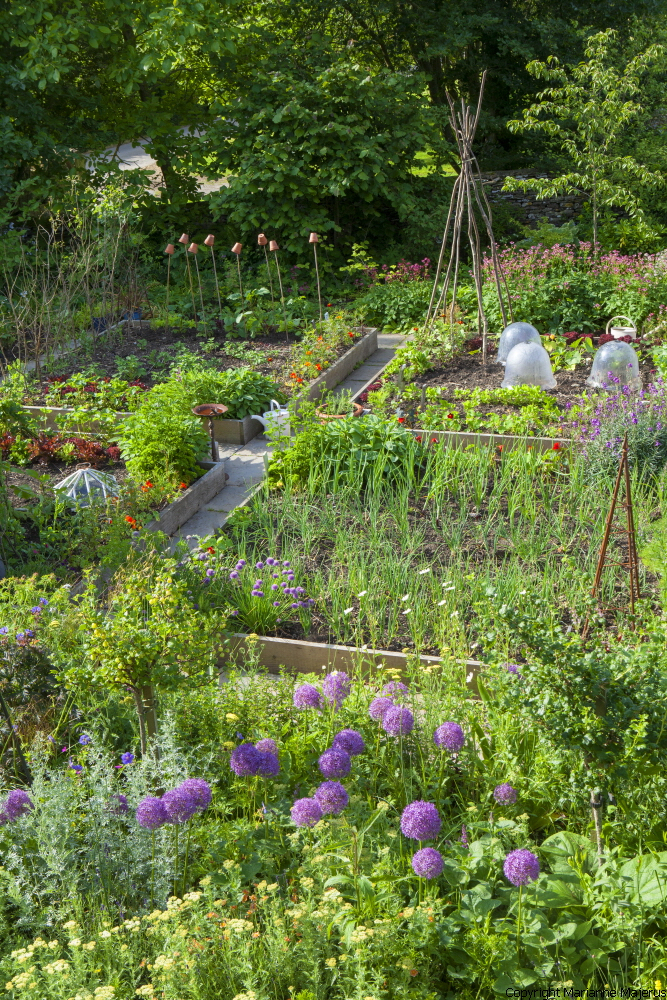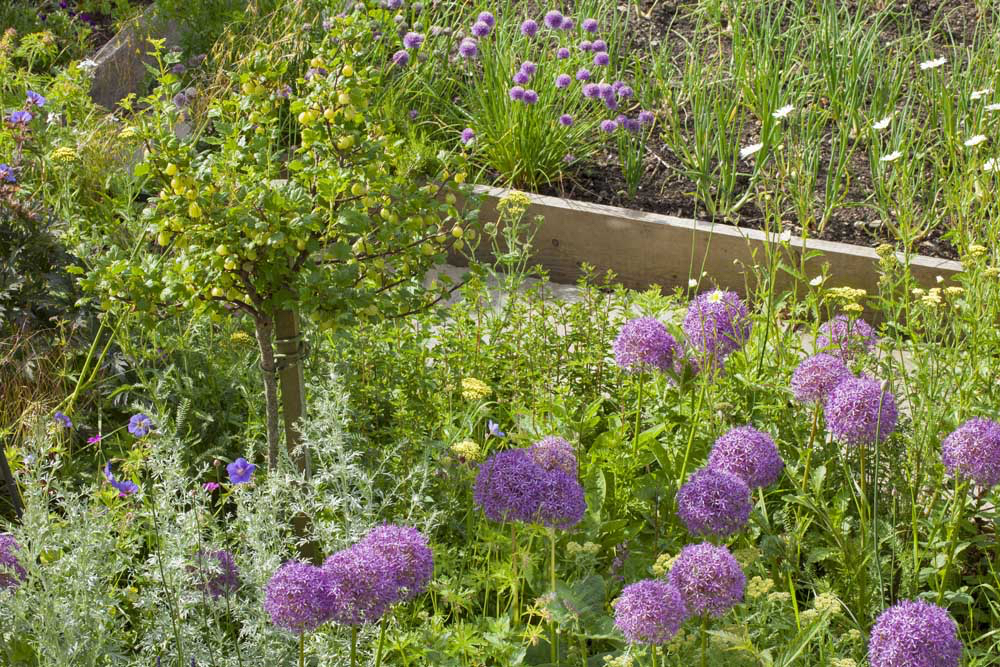
There’s one plant I really look forward to in May and that’s the tall, statuesque allium, because they provide strong verticals, round or drumstick heads and vibrant colour. They’re versatile too, because these tall early-summer alliums look equally at home in the vegetable garden, or the flower border, and you can create your own river of colour. Mine flow up the front path close to standard gooseberries and the combination of pale-green fruit and purple domes sums up early summer.
They are particularly useful near greenhouses, because they link the edible with the floral having a foot in each camp because they are members of the allium family. They’re bee-friendly too, so they’ll pull in the pollinators and most of the tall alliums return year after year with little fuss. They’re planted in autumn, along with the daffodils, and come up smiling in spring.
Perhaps the most useful of all is Allium hollandicum ‘Purple Sensation’, because this is the perfect follow-up act for later flowering tulips, with deep-purple domes held on strong three-feet high stems. The flowers fade beautifully forming fresh-green seed heads, although it’s vital to cut them off or pull the stems away before they sprinkle hundreds of seeds over your garden. Catch them at the right time and they make a wonderful dried flowers.
There is a snag. Isn’t there always? Their foliage emerges early in the year, because most alliums are snow-melt plants, and by the time the flowers appear the leaves look jaded. The trick is to plant them with perennials so that their new growth covers the unsightly allium foliage. It might be a well-behaved Nepeta, such as N. racemosa ‘Walker’s Low’, or a hardy geranium such as ‘Orion’, or the sterile Jacob’s ladder Polemonium ‘Lambrook Mauve’. The lilac flowers of this polemonium have a soft-orange eye which catches the terracotta, scented tulip ‘Ballerina’.

‘Purple Sensation’ has been around for over 50 years, having been selected in Holland by J. Bijl, so it’s as cheap as chips to use a ‘Jamie Oliverism’. The true form is a glowing deep-purple that jumps out in the garden. You can make it even more vibrant with a touch of apricot-orange, courtesy of Geum ‘Totally Tangerine’.
Once ‘Purple Sensation’ appeared on the scene Dutch plant breeders began to hybridise and select new varieties. One of them is Allium ‘Purple Rain’. It’s a softer colour than ‘Purple Sensation’ and the flowers are formed of tiny little stars arranged in a loose umbel. These resemble its other parent, the sun-loving lilac-flowered A. cristophii.
Consequently ‘Purple Rain’ flowers in early June, a good month later ‘Purple Sensation’, and you’ll get six weeks of colour if you plant both together. It’s proved enduring and is far easier to keep than A.cristophii , which needs really sharp drainage and a garden hot spot to survive British winters. I’m very fond of ‘Purple Rain’ for its giant’s dandelion clock arrangement. Plant it close to Euphorbia characias, the Mediterranean grey-leaved spurge, and the lime-green flower heads will bring this allium to life.
Many of the best hybrids are sterile, which means that they don’t set seeds. As a result, the flowers last much longer and almost dry on the plant. The fact that they don’t set seeds makes them expensive to buy, which puts a lot of gardeners off. You may have to pay roughly £4.00 per bulb because it takes the grower several years to produce a flowering-sized bulb. However, once planted, these hybrid alliums stay with you for many a year, so they are good value.
‘Gladiator’ is a tall, lilac-purple allium and each perfectly formed tiny flower has a pinpoint of green in the centre of the flower, something I find irresistible. This will top 5 feet in height ( 150cm). The fact that it’s been around since the 1980s means that it’s affordable and Rose Cottage Plants – see below- supply three bulbs for £6.00. The other widely available, reasonably inexpensive tall allium is ‘Globemaster’ and this has been around since the 1970s. It will reach 4 feet in height (120cm)and the aster-violet flowers have a strong honey sent, drawing in the bees.

More recent varieties include the summer-flowering ‘Jackpot’, a shorter variety only reaches 28 inches (70cm). And, if you like short varieties with larger flowers, try ‘Pinball Wizard’. The heads consist of hundreds of tiny lilac-silver starry flowers. ‘Beau Regard’ is a slightly taller allium with a tighter arrangement of flowers and the colour is similar, but with a bluer, almost-lavender cast. The strong green stems are a real feature and, although a little pricey, it’s certainly worth the money. These short alliums with large flowers are better planted in a group in a strategic place at the front, or end of border. They get lost among herbaceous plants as they’re not very tall.
Perhaps the longest flowering allium is ‘Ambassador’, a completely sterile giant with dark-purple flower heads that measure 8 inches in diameter. It’s 3 to 4 feet in height and flowers usefully late. The heads are completely spherical and, not surprisingly, all the best bulb suppliers rate it really highly. Good seed heads follow.
I’m itching to grow a very recent, pink-flowered allium introduced at the Chelsea flower show of 2016. It’s called ‘Twinkling Stars’ and it’s a hybrid of A. giganteum. It will reach 5 feet in height and each flower measures 5 inches across. However, it’s the colour that makes it so attractive, because it’s the first tall pink allium. At the moment it’s £9 per bulb so I may have to save up before I can afford to plant a river of these!
Allium Tips
Use a reputable supplier who will sell you good forms of the correct thing.
Be prepared to pay for the larger allium bulbs. They take many a year to produce.
Plant in autumn, at twice the depth of the bulb.
Plant taller alliums in sevens, nines or more to create a ribbon of colour.
Give them good drainage and a warm, bright position.
Feed every spring with a potash-rich fertiliser, such as Vitax Q4.
Hide the foliage with low-growing herbaceous plants, because the leaves emerge early and die back long before the flowers appear.
Do not let alliums self seed! They will produce hundreds of grassy nuisances.
Top up with more bulbs in the autumn, as needed.











